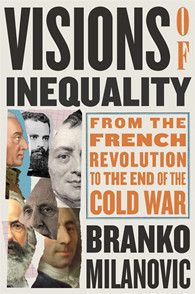
VISIONS OF INEQUALITY
From the French Revolution to the End of the Cold War
Branko Milanovic
Belknap Press
Cambridge, MA, 2023, 368 pp., $32.95
Rising economic inequality in many countries, especially the rich ones, in recent decades has emerged as an important topic of political debate and a major public policy concern. Widening economic disparities and related anxieties are stoking social discontent and are a major driver of the increased skepticism about public institutions, political polarization, and populist nationalism that are so evident today. Visions of Inequality, a new book by Branko Milanovic, a leading scholar of inequality, places today’s concerns and debate in context. It is an absorbing account of how thinking about inequality has evolved.
The book chronicles the way the economics discipline has viewed and analyzed inequality from the French Revolution to the end of the Cold War. It carefully distills the writings of six of the most influential economists of that time—François Quesnay, Adam Smith, David Ricardo, Karl Marx, Vilfredo Pareto, and Simon Kuznets—with a chapter devoted to each. It then reviews the work of neoclassical economists and inequality studies during the Cold War period. The book concludes by examining advances in the analysis of inequality in the more recent, post–Cold War period. In all, it is a sweeping, erudite treatise on the intellectual history of inequality.
The earlier economists’ thinking about inequality was framed mainly around social classes and means of production—landowners, capitalists, workers. Their analysis focused more on the functional distribution of income—rents, profits, wages. Pareto framed inequality in terms of a social hierarchy of elites versus the rest of the population. With Kuznets and later neoclassical economists, the analysis shifted toward individuals and interpersonal distribution of income, a shift aided in part by greater availability of data on individual income. The new data and tools enabled the study of income distribution across individuals along various dimensions, such as educational attainment or urban versus rural location. Milanovic traces this evolution in economic thinking about inequality from classes to elites to people in rich detail, also showing how ideas about inequality were inextricably linked to historical context.
Milanovic calls the second half of the 20th century, spanning the Cold War, a “long eclipse of inequality studies.” The relative lack of attention to distributional issues in part reflected the faith of neoclassical economists in the functioning of markets and their outcomes. In addition, inequality within Western economies initially moderated during this period, helped by rising demand for labor supported by stronger postwar economic growth, improvements in education, and the introduction of social welfare programs. According to Milanovic, these factors—which diminished attention to inequality in economists’ work and public discourse during the Cold War—were reinforced by the politics of the era. Each side wanted to present itself as less class based and less unequal than the other: the competition between capitalism and communism pushed economics into the service of the ruling ideologies’ political ends.
The picture has changed in recent decades. Inequality has resurged, driven by a combination of factors: the differential impacts of technological change and globalization across firms and workers and the current institutional and policy settings. These include the state’s weakened redistributive role as tax progressivity declined and social programs were squeezed by tighter fiscal constraints. This has prompted economists to refocus their attention on inequality. Inequality has risen not only in Western economies, especially in the United States, but also in post-Soviet Russia and in major emerging market economies, such as China and India.
In the book's epilogue, Milanovic reviews how contemporary economists have expanded the frontiers of the study of inequality. The work of Thomas Piketty stands out in this context, especially in furthering the analysis of the role of wealth and nonlabor income in inequality. Inequality studies have a wider compass, reaching beyond a narrow neoclassical focus on markets to social and political power structures. These studies incorporate factors such as gender and race and examine inequality in broader dimensions than just monetary income. And the focus now extends beyond inequality among citizens within countries to include inequality among global citizens, an area of pioneering work by Milanovic.
There is a silver lining to recent inequality dynamics: inequality within countries has been rising, but global inequality (the sum of within-country and between-country inequality) has been falling. Developing economies are narrowing the income gap with rich countries. But, looking ahead, global economic convergence faces new challenges as the world’s growth outlook weakens (especially for developing economies), geopolitical tensions and the risk of geoeconomic fragmentation threaten trade and investment between countries, and technology alters the structure of international comparative advantage.
Visions of Inequality is an important scholarly work. But it is also a good read. Milanovic mixes his methodical examination of the evolution of economic thought about inequality with fascinating portraits of great economists and the society and polity of their times.
Renewed and deeper attention to inequality is timely. As Walter Scheidel documents in his book The Great Leveler, which reviews the history of the consequences of inequality, large and persistent increases in inequality can end up badly.
Opinions expressed in articles and other materials are those of the authors; they do not necessarily reflect IMF policy.








